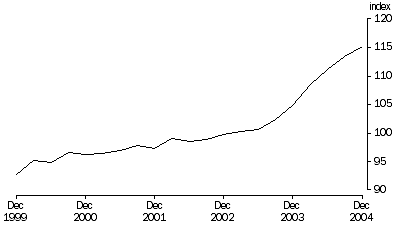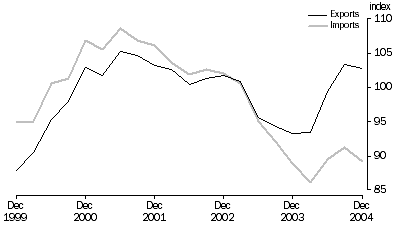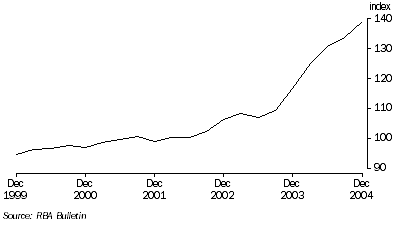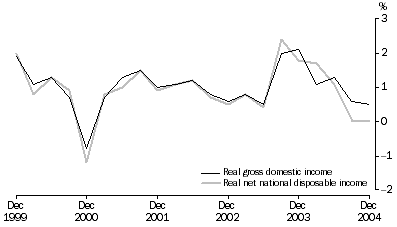Feature Article - The Terms of Trade and the National Accounts
This article reproduced from Australian National Accounts: National Income, Expenditure and Product, Dec 2004 (cat. no. 5206.0
INTRODUCTION
The most commonly used measure of overall economic performance is the chain volume measure of gross domestic product (GDP). It is a broad measure of economic activity which focuses on the value added of resident producers. Because Australia is an open economy, changes in GDP are influenced by growth rates in volumes of exports and imports of goods and services, and in recent times the trade balance (exports less imports) has been a significant contributor to movements in GDP. However, the direct impact of another aspect of Australia's external economic activity - the terms of trade - is not reflected in the chain volume measure of GDP. The terms of trade is a measure of the relative prices for exports and imports. This article discusses various issues surrounding the terms of trade and the national accounts.
GDP AND THE TERMS OF TRADE
GDP can be measured in three different ways:
- by differencing total output and total intermediate inputs (the production approach)
- summing final expenditures (the expenditure approach)
- summing incomes from production (the income approach).
The most useful approach to consider in relation to the terms of trade is the expenditure approach. The expenditure approach is defined by the equation:
GDP = Consumption + Capital formation + Exports - Imports
When measured in current prices it can be seen that if export prices rise and import prices are unchanged then current price GDP will increase (assuming underlying volumes are unchanged). In relation to the other measures of GDP, this increase in GDP will be reflected in increases in the total value of output and increases in factor incomes - most likely increased gross operating surplus (GOS).
While there is a current price impact, since the terms of trade is a price measure, its impact is not reflected in the volume measures of GDP. However, changes in the terms of trade can have an important impact on real incomes. This outcome - the so called terms of trade effect - is demonstrated in a short example in the appendix to this article.
One way of thinking about the terms of trade effect is that if export prices are rising relative to import prices (i.e. the terms of trade is increasing) then the income accruing to Australian producers is increasing with the result that, for a given volume of exports, a larger volume of imports can be purchased. Thus changes in the terms of trade reflect changes in the real purchasing power of the Australian economy overall. It is this change in the purchasing power that is not reflected directly in measures of GDP in volume terms and which may lead to the view that GDP is misstating the true state of economic activity. This perception may intensify if improvements in the terms of trade are large and ongoing and hence the gains from changing purchasing power are reflected in many component series of GDP such as household consumption, which may be met by increases in domestic production or in import volumes or more likely, a combination of both.
While the situation is not often as straightforward as just described, measurement of the terms of trade effect on national accounts aggregates is an important aspect in presenting a full picture of economic performance.
MEASURING THE TERMS OF TRADE
In theory, there are a range of ways in which the terms of trade could be measured. Traditionally, in the ABS, implicit price deflators (IPD) for exports and imports of goods and services have been used to measure the price changes. IPD are calculated by dividing the current price value of an aggregate by its corresponding volume estimate. The ratio of the IPD for exports of goods and services and the IPD for imports of goods and services provides the estimate of the terms of trade.
The graph below illustrates that Australia's terms of trade (in seasonally adjusted terms) has risen 24.3% since the December quarter 1999, resulting from an 17.0% rise in the IPD for exports of goods and services and a 5.9% fall in the IPD for imports of goods and services.
Terms of trade, (2002-03 = 100)
 Imports and exports, Implicit price deflators - (2002-03 = 100): Seasonally adjusted
Imports and exports, Implicit price deflators - (2002-03 = 100): Seasonally adjusted

A further decomposition shows that the terms of trade for goods have risen by 27.8% compared with a 12.5% rise in the terms of trade for services.
As mentioned, the recent rises in the terms of trade reflect rises in export prices and falls in import prices. However, since the terms of trade is a relative price measure, movements in the terms of trade may be due to any one of a number of combinations of export and import price movements.
FACTORS INFLUENCING THE TERMS OF TRADE
There are a range of factors that will influence movements in the terms of trade, especially given the diversity of goods and services which are traded. One factor which has been particularly prevalent in recent quarters is the solid rise in commodity prices for key Australian exports (footnote). The graph below shows the growth that has occurred in commodity prices (measured in US dollar terms) particularly since late 2003.
Commodity prices, (2001-02 = 100) - Quarterly average

A longer term factor that has a positive influence on the terms of trade is the general decline in prices of high technology goods. As Australia is a net importer of these goods, this price trend lowers growth in import prices relative to export prices.
A more complex factor influencing the terms of trade is the exchange rate. If prices for exports and imports are all denominated in a common currency (say Australian or US dollars) then a change in exchange rates will have no impact on the terms of trade as the exchange rate change will impact on export and import prices equally. However, since exports and imports are traded in various currencies, exchange rate movements will impact on the relative prices of exports and imports in Australian dollar terms to some extent.
By way of a simple example, if exports were denominated in Australian dollars and imports in US dollars then an appreciating Australian dollar exchange rate would lead to unchanged export prices but lower import prices, thus improving the terms of trade, all else being equal.
At present it is estimated that about 70% of export contracts and 50% of import contracts are written in US dollar terms. Given these proportions and the general improvement in the Australian exchange rate against the US dollar (see graph below), it is reasonable to conclude that only some of the growth in the terms of trade in recent quarters is attributable to the rising exchange rate.
Australian Dollar, Quarterly average

ALTERNATIVE NATIONAL ACCOUNTS AGGREGATES
As discussed, the terms of trade does not have a direct impact on volume growth in GDP. However, measures can be derived that allow for the impact of the terms of trade and hence provide other indicators of the strength of the Australian economy. The most well known of these alternative aggregates is real gross domestic income (RGDI).
In practice, the purchasing power of the value of Australia's exports over its imports is measured by deflating the value of exports in each period by the price deflator for imports. The difference between this purchasing power measure and the volume measure of exports provides an estimate of the impact of changes in the terms of trade in a particular quarter or year. Taking differences between any pair of quarters / years provides an estimate in the change in the purchasing power of exports between those periods. RGDI is estimated as the volume of GDP plus the 'terms of trade effect' as described above. Thus, if import prices are falling relative to export prices, then for a given current price amount of exports, the volume of exports will be higher and growth in RGDI will be greater than that in the volume of GDP.
While other approaches to measuring the terms of trade effect could be used, this approach has been chosen as its interpretation is quite straightforward and it can be derived easily.
In recent years as the terms of trade has been rising, growth in RGDI has been stronger than growth in volume GDP (see graph below). The difference in recent quarters is quite pronounced as the strength in the terms of trade has been much greater. The growth rate in RGDI in the year ended December quarter 2004 was 3.5%, 2.0 percentage points higher than the growth rate in volume GDP of 1.5%.
GDP and RGDI, Volume measures - Seasonally adjusted

The other key national accounts aggregate which adjusts for the terms of trade is real net national disposable income (RNNDI). This aggregate goes beyond RGDI as it also takes into account changes in real net income flows to the rest of the world (e.g. dividend and interest flows) and the depreciation costs of fixed capital (consumption of fixed capital in national accounting terms). This aggregate is considered by the ABS to be a key measure of economic wellbeing. Movements in RNNDI compared with movements in the chain volume estimate of GDP are generally heavily influenced by changes in the terms of trade. As such, the graph below shows that differences between RGDI and RNNDI are generally small. However, in recent quarters RNNDI has shown lower growth than RGDI reflecting strong growth in property income (dividends and interest) payable to the rest of the world.
RGDI and RNNDI, Volume measures - Seasonally adjusted

INDIRECT EFFECTS OF CHANGES IN THE TERMS OF TRADE
The terms of trade is a relative price measure and not simply a case of either export prices rising and import prices falling or vice versa. Further, the composition of exports and imports will change over time, relative price changes within exports and imports will change, there will be varying price elasticities and there will be exchange rate influences. As a result, there are many possible economic outcomes from either an increase or decrease in the terms of trade.
The recent improvements in the terms of trade have reflected trend rises in export prices and trend falls in import prices. In such a situation the following possible outcomes are ones that are most likely to be observed in the national accounts.
- Falling import prices might be expected to lift demand, in volume terms, for imports of goods and services.
- This increase in demand for imports is likely to be reflected in stronger growth in the volume of domestic final demand (household consumption and investment in machinery and equipment in particular).
- Rising export prices might be expected to provide a boost to the nominal incomes of exporters and hence their operating surplus.
- In turn, these increases in operating surplus may lead to benefits to domestic shareholders in terms of increased dividend payments and are also likely to be reflected in higher property income payments to foreign direct investors.
Each of these possibilities can be monitored in the various data tables within the quarterly national accounts publication although ascribing any movements solely to the terms of trade effect would not be appropriate.
FURTHER INFORMATION
Further information on this article may be obtained by contacting Michael Anderson on (02) 6252 6713 or by email at michael.anderson@abs.gov.au.
APPENDIX
The effect of an improvement in the terms of trade can be illustrated by way of an example. Assume that wheat is the only good produced in Australia. In year 1, 10 million tonnes of wheat are produced, priced at $100 per tonne giving a total value of production of wheat of $1,000 million. Part of the wheat (30 per cent, worth $300 million) is exported while the rest is consumed within Australia. Imports in the same period consist only of diesel fuel (1 million kilolitres at $300 per kilolitre resulting in a total value of $300 million). These imports are used up entirely in the process of producing the wheat. Therefore, the value of GDP is $700 million ($1,000 million of output less $300 million of intermediate input).
Further assume that the only change between year 1 and year 2 is an improvement in the terms of trade as a result of a fall in the price of diesel from $300 to $240 per kilolitre. If year 1 is the base period then the implicit price deflator (IPD) for exports will be 100.0 in both years while the IPD for imports will be 100.0 in year 1 and 80.0 in year 2. As a result the terms of trade have improved from 100.0 to 125.0 between the two years. The same volumes of wheat are produced, consumed domestically and exported, and the same volume of petroleum is imported. In volume terms, the expenditure side of the national accounts in year 2 expressed in year 1 prices will be identical to that for year 1. There is no change in any of the components or in total GDP (in volume terms) because all the underlying volumes are identical in both years.
However, in current prices, the expenditure side of the national accounts for year 2 does change, as the value of diesel imports falls and hence GDP rises. These outcomes can be seen in the following table.
 | Current price values
| Volume terms
|
 | Year 1 | Year 2 | Year 1 | Year 2 |
 | $m | $m | $m | $m |
|
| Private final consumption expenditure | 700 | 700 | 700 | 700 |
| Exports | 300 | 300 | 300 | 300 |
| less Imports | 300 | 240 | 300 | 300 |
| Gross domestic product | 700 | 760 | 700 | 700 |
|
For year 2 the same result is obtained using the production approach to measure current price GDP ($1,000 million of output less $240 million of intermediate input). It is apparent that the income available from the production of the same volume of output has risen because of the improvement in the terms of trade which resulted from the fall in import prices.
In the simple example above, the estimate of export volumes in Year 2 adjusted for the terms of trade effect would be $375 million. This is obtained by deflating the current price value ($300 million) by the imports IPD (80.0). The impact in real incomes once adjustment is made for the terms of trade effect would be as follows:
 Print Page
Print Page